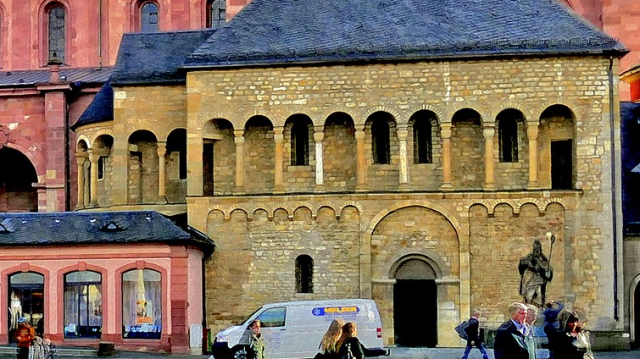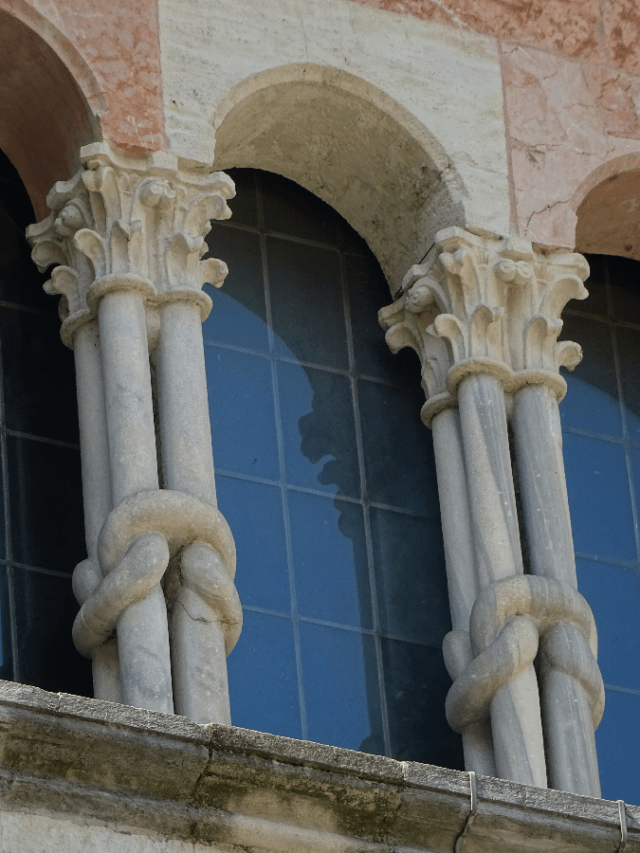
The paired bell towers of the Basilica Sant’Abbondio in Como – Romanesque masterpiece of the Maestri Comacini.
Como is a city of art and culture built up over centuries of tradition originating from the advanced bronze age culture of the Golasecca. The Golasecca lived in the area known as Insubria that includes Como, its and the other Lombardy lakes and a good part of the Swiss Canton Ticino. At certain periods in history, the area has produced ‘schools’ of artists and artisans who have achieved pan-European significance. The most recent were the so-called ‘Artisti dei Laghi’ who, as painters, sculptors and craftsman in other decorative arts, left their mark in churches and palaces across Italy and Europe, with possibly their best-known landmark being the Ludwigsburg Palace designed by Donato Frisoni (born in Laino near Como) and built for Duke Ludwig in 1733.

Interior – Ludwigsburg Palace
Yet they in turn would have gained some inspiration from a tradition in masonry, sculpture and stone carving emanating also from the area of Insubria – the so-called ‘Maestri Comicini’. These artists and artisans helped develop and spread the Romanesque style of religious building across Europe in the 11th and 12th centuries.

Carved marble denoting the good life for young Como residents in the Roman era – a day out hunting, in the Museo Archeologico.
So let’s focus on this early group of artist/artisans to understand more about what they achieved. Como was established by Julius Caesar and from the start it appears that the ‘Comacini’ had a talent for stone sculpture. Pliny the Younger had a summer villa built on the site of the current Villa Pliniana and he cited the ‘most excellent work’ of the Como builders in a letter to the Emperor Trajan.

Sentee di Sort – Ex-limestone quarries above Moltrasio.
They were of course aided by the natural advantages of the area, as in the supply of Moltrasio limestone used extensively for building due to its unique strength yet ease of working. It also formed natural strata which made extraction and cutting into regular shape that much easier.

Multi-coloured marble facing of the Broletto, Piazza Duomo
Black limestone and marble were available from Varenna and white marble from Musso – hence so many two-shaded facades to Como buildings. Como was also well placed for communications on one of the main ancient north-south axes in Europe on the Rhine branch of the Via Francigena crossing the Alps at Splugen thus providing a link from Rome through Milan, to Como and then Chiavenna on up into Northern Europe.
The Lombard invasion of Italy secured a role for the Maestri Comacini as preservers of the Roman building and stone masonry skills. Little building was done by the Lombards until the 7th century when Queen Teodolinda converted to Christianity and started an extensive building programme led by the Maestri Comacini in Monza, Milan and, primarily in the Lombard capital, Pavia. The first formal mention of the Maestri Comacini comes in a text written by the Lombard king Rothair in 643 CE. By this stage, they were formally licensed as a guild and given the right and protection to travel as itinerant craftsmen.
They took as their early inspiration the iconography from both pagan Lombard sources and early Christianity. Many of their interlacing geometric stonework designs are reminiscent of Celtic work. Additionally they portrayed mythical monsters and symbolic beasts.

Maestri Comacini work on the exterior of the Basilica Sant’ Abbondio.
A German musicologist, Marius Schneider, has gone so far as to suggest that the repetitive patterns and mythical designs of the maestri incorporated a form of musical annotation encrypting the Gregorian chants dedicated to their patrons.
One design oddity is the development by these maestri of the so-called ‘nodo comacino’ as a carved device around a single or multiple columns performed to show off the dexterity of the stonemason. Examples of this can be seen on the east side of the Broletto in Como’s Piazza Duomo.
As time progressed they developed a ‘Romanesque’ style of stone decoration with main examples of their work still visible on the exteriors of the Romanesque churches San Fedele (built 1120 CE) and Sant’Abbondio (rebuilt between 1050 and 1095 CE). They worked on one of the very first Romanesque buildings, the Baptistry of St. John at Galliano near Cantu (built 1007) and also on the church of Sant’ Ambrogio in Milan.
Further stimulus to work abroad occurred after 775 CE when Charlemagne defeated the Lombards in Pavia and thus encouraged the stonemasons to look at the opportunities beyond the Alps. Their fame spread abroad as testified by Archbishop Aribo of Mainz (known as Magonza) when he passed through and subsequently died in Como on his return from a pilgrimage to Rome in 1031. He took the opportunity to seek out Maestri Comacini to work on rebuilding his cathedral in Northern Germany.

Mainz Cathedral
Certainly by 1050, Maestri Comacini were working north of the River Danube. Their fame would extend up the old pilgrim route up the Rhine for them to undertake commissions in Denmark and Sweden.

Bell Tower of the Basilica San Fedele, Como
The whole area around Lake Como is rich in churches built in the Romanesque style dating back to the times of the Maestri Comacini. They may not have been the only exponents of this style but the wide diffusion of their skills across Europe certainly led to them having a primary role in the widespread adoption of this style of architecture on a truly pan-European basis from Sicily to Sweden and from Spain to Russia. Local historian, Marco Lazzati is prepared to state: ‘After the Latin language and the spread of Christianity, the first ‘Euro’ to circulate in Europe and to thus partly contribute to unifying its culture was the Maestro Comacino .’

Eastern exterior of the Broletto, Como. Nodo Comacino – a technique developed by the Maestri Comacini showing off their abilities.
Their ability to circulate was originally granted by the safe passage accorded members of the ‘guild’ by the Lombard kings and the church authorities of the time. Very quickly they established an itinerant culture setting up camp alongside (even attached to) the construction sites on which they worked. This not only led to the diffusion of the Romanesque style but also some have claimed it formed the basis of European Freemasonry. Their status in the 12th and 13th centuries was that of ‘liberi muratori’ which can be literally translated as ‘free masons’. The barracks they set up on the building sites were known as ‘logge’ or ‘lodges’. The secrecy associated with freemasonry may stem from the oaths of secrecy taken by members of the masonry guild to not divulge any of the secrets imparted by the ‘maestri’ (masters) to their apprentices about their trade. In addition, they signed their works by leaving carved symbols with that of the Maestri Comicini being an open compass above a rose.
The artistic merit of the Maestri Comacini may well have been undervalued over the years with the tendency to dismiss them as mere artisans but they were working at a time when ‘art’ was indistinguishable from ‘craft’. The lack of documentation also prevents us from singling out individual master craftsmen but note must be taken of their obvious impact on their environment with the rich legacy of Romanesque structures that populate Lake Como and beyond. Their contribution to this in Como, around the lake, in Lombardy, in Italy and in Europe is outstanding.
















